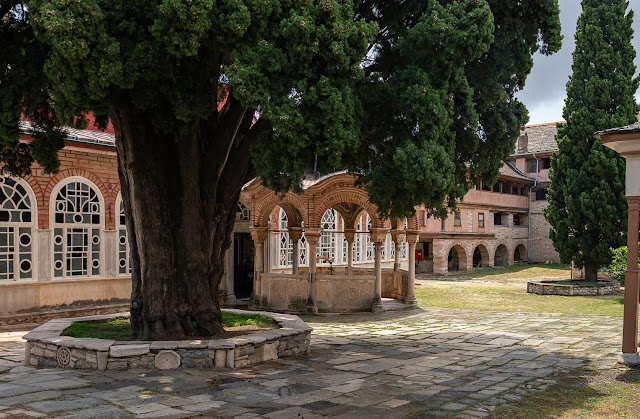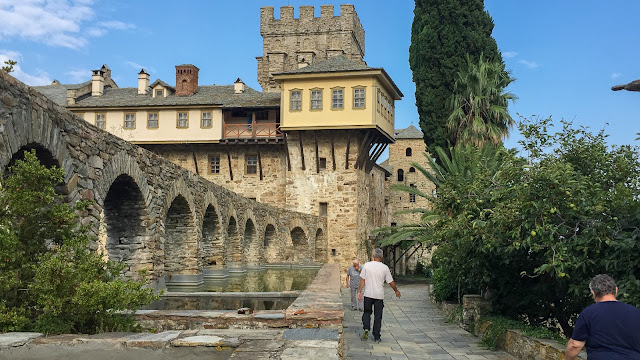1000 Steps to Mount Athos
I travelled to the Holy Mountain Athos, along ancient paths, climbing thousands of steps, accompanied by birdsong in a natural environment that remained untouched for thousands of years. I visited seven monasteries, always being hosted and fed by holy monks, sinking back into ancient spaces and times. For me, it was also going back to my own past, to the seasons on Elba island from which my family comes, to the background noise of the waves breaking on the rocks, to walking uphill like a devotee along a Way of the Cross up the mountain of that island, to where at the top was a sanctuary, and ultimately to my going by sea - as always.
July 2018. As I was waiting together with other passengers to board the ferryboat called Micro Aghia Anna, I felt a mix of expectation and excitement. I stood at the pier of Ouranopolis, the last outpost before the Mount Athos Independent Territory, in the easternmost peninsula of the larger Chalkidiki peninsula in central Macedonia, around 50 kilometres long and 7 kilometres wide, home to some 20 monasteries and an uncontaminated nature. With its height of 2030 metres, Mount Athos is an imposing presence at the southern end of the peninsula. I had arrived the day before from Rome, via Athens and Thessaloniki, a beautiful lively coastal city, tasting bougatsa - a delicious flaky, creamy pastry.
The captain of the little boat was waiting for the Greek police to check our passports and the *diamonitirion*.
The diamonitirion is the entry permit to Mount Athos, granted by the community of the same name. It was valid for three nights, but it could be extended at the Karyes administrative offices. My first destination was Aghia Anna, Saint Anne, a smaller monastic community regrouped in a skete, or skiti, made of several houses and cells with one or two monks each, often dependent from a larger monastery. We boarded and took our seats, monks in front...
The captain gingerly backed the boat out from her moorings, and swiftly accelerated to start our journey along the coast dotted with monasteries high over the steep rocky coastline. After a few stops to offload goods and passengers, we arrived at Aghia Anna harbour. Only four of us alighted: a monk and three regular passengers, including me. A steep ascent of 1100 steps or about 300 metres above sea level, was awaiting me.
The monk was most likely used to it, as he got ahead and quickly disappeared in the distance. There was no other sound...
...but the hoofs of the mules clacking on the pavement, the calls of the Albanian muleteers, the rustling of the wind on the tree leaves, and the voices of pilgrims descending to the harbour I just left. The views were breath-taking, the sea shone under the clear sky, blue as a precious stone, while the Mountain hovering above me had its summit covered in clouds. We finally reached the church and a terrace, and the Guest Master welcomed us with raki, a liqueur made of anisette, lookoums and water.
I rested. After a quick lunch of lentils, cucumber and tomatoes, I went exploring. The Holy Mountain with its cloud-shrouded summit was towering 2030 metres high. I felt suspended between the sky, the Mountain and the sea below...
...between times and thoughts and dreams. Late in the afternoon we were allowed to pray to Saint Anna who protects women’s womb and facilitates pregnancies.
A Saint Anna’s belt, anointed by the monks, was on sale to pilgrims. I bought one at the wish of my Greek language teacher, Maria, married to Stefano, an Italian. She later delivered a beautiful baby girl, who the couple aptly named Anna.
The evening went by talking to other pilgrim, in the pure air scented by laurel and myrtle.
Next morning, upon descending from Saint Anna monastery, I stopped at the harbour. Waters around the Mount Athos peninsula are clear and rich in fish, no one other than the Monastic Community of Mount Athos may fish here. While I was waiting for the ferry, I watched a holy father returning from fishing. Father Grigori, as I learned later, pulled the boat up, covered it with old tarpaulins, and loaded his mule to go up to Saint Anna. Then, before taking the first of the 1100 steps, he called me to proudly show me his catch: two big buckets, one full of calamari and the other with a mixed variety of fish.
The room, the dinner, and the reception were spartan.
I took the ferry to Dafni, the main harbour of the territory. Isolated cells and small houses are clinging to the vertical cliffs along the coast; they are accessible only through a system of ropes.
Whoever lived here was completely isolated from the world, left to contemplate the rhythm of the sun in a mystical union with God. Bags of Mail were on the deck of the little ship.
“Government in the Fourth Dimension — The Earth is behind us. Prostrate in the guest-room at Iviron, we lie upon another plane of existence, back in that mysterious, immaterial *regnum* from which the mind cast loose with the Renaissance. […] How comes that this fragment of life, which once held sway over all the Greek seaboard endures unaltered since its foundation, the most remarkable testimony to Europe’s evolution on the face of the Europeanised globe?”. From Robert Byron, The Station, Travels to the Holy Mountain of Greece.
Founded in 976, Iviron is the second oldest monastery of the eastern seashore of Mount Athos peninsula. The first monastery, the Great Lavra, was established in 963. I wait in the large reception room with other pilgrims. My single bed room was very comfortable...
...while down the corridor was a small but comfortable reading room.
Communal dinner was almost sumptuous as compared to earlier evenings and the pilgrim were summoned to dinner by rhythmically hitting a wooden board with a mallet.The church of the Great Lavra Monastery...
....the oldest monastery in the Mount Athos Independent Territory, was built by St. Athanasius the Athonite in 963 AD. The entrance is guarded by two cypresses planted by St. Athanasius himself and Euthymios of Daphni.
The vestibule of the church “conceals a pair of magnificent Turkish baroque wooden doors...
deeply undercut to represent the eagles of the Orthodox Church, below which the church they adorn is transformed into the semblance of a triple-towered pagoda. These are painted gold, brown, mustard, organic and deep blue, on a background of white. They give entrance to the church proper …” (The Station, Robert Byron, Tauris Parke Paperbacks, 2011, page 78).
The pilgrims’ quarters were full of light reflected by the sea below.
Five Greeks took me under their protecting wings. I went to Karakallou Monastery where I did religiously participate in the devotions as any other pilgrim of any religious background, at the crack of dawn, while the disabled monks were carried on a wheelchair.
A few monks preferred to be deeply praying just outside the church walls.
This photo courtesy of Georgiou Makedonis
I walked ancient paths, climbed thousands of stairs, met five boisterous Greeks who took me under their wings, shared food, sleeping rooms, and boats with me.
It was a most unique and spiritually enriching trip, where I lost the sense of space and time immersed in undamaged nature, surrounded by the blue of the sea, mesmerised by the presence of Athos Mountain, listening to birds chirping, fountains, running water and the rhythmic call to church, made by monks hitting a simple wooden board with a wooden mallet. With the five Greeks we laughed a lot, we talked a lot and promised to meet again.


































Gianni...all that one can say is: BELLISSIMA !!!
ReplyDeleteThank you Fouad for your kind comment! Best, Gianni
DeleteMy husband Ralph Diaz and I used to travel with the XUNICERers. Now he is gone, and I am happy to still be able to travel through these articles. Coming from Asia, I find travel stories from other parts of the world very unique and interesting. Thank you for exporting me to another place, especially during this pandemic. Maria Diaz
ReplyDeleteThank you Elsie. I am happy you liked the article and that reading it gave you joy! Best regards, Gianni
DeleteGianni, An exciting and spiritually elevating adventure. You carry us along with you sharing the depth of your emotions, experiences and feelings. Many thanks. Farid
ReplyDeleteThank you Farid for your kind words and I am happy you liked the article. I am also very happy to be in touch again! All the very best
DeleteGianni, An exciting and spiritually elevating adventure. You carry us along with you sharing the depth of your emotions, experiences and feelings. Many thanks. Farid
ReplyDeleteGianni, An exciting and spiritually elevating adventure. You carry us along with you sharing the depth of your emotions, experiences and feelings. Many thanks. Farid
ReplyDeleteGianni,
ReplyDeletethank you for sharing this exciting and unique pilgrimage.. I was keenly interested as I love antiquity and "old living places" and it reminded me of the "being restored " churches in Armenia and Georgia. I want to tell you that Gururaja also found your narrative and pictures interesting and informative. Sree
Thank you Sree for your most kind comment. I am happy that Gururaja also foundd it interesting! Million thanks, Gianni
DeleteWhile the mountain and buildings are beautiful, the communities are parasites, living off EU money, yet excluding visits from half of humanity. Moreover, the monks do no "good works" as many do elsewhere. Instead, all they care about is praying for their own "souls" -- when not on their cell phones or running around in jeeps (don't fool yourself that this is medieval monasticism).
ReplyDeleteWhen I went, many of the monks were rude (despite my ability to get along with some Greek) and the dorm and toilet were so filthy in one monastery that I left ahead of schedule.
The EU should make it a condition of support that women be allowed entry. Or Greece should just nationalize the mountain and turn it into cultural site.
Such a comment might have benefitted more if the author would have signed the comment with his or her name and not just with Unknown ... Names of monastery or monasteries the author found filthy might have added some specificities. No one wants to fool anyone, but sharing of my experience was at the essence of this article.
DeleteViewing this while on vacation myself, it was therapeutic, transporting the imagination. May the hosts and ambassador- visitors (like you) refine it and improve its inclusivity (noting negative comments)to the honor of God and God alone !
ReplyDeleteGianni,
ReplyDeleteYou have carved out a beautiful story from a place unknown to me till now - rich in history, culture and religion. I felt I was on this pilgrimage as you narrated your journey and shared your magnificently captured images. Thank you!
Thank you Doreen for your kind words!
DeleteDear Gianni, what a treat? Your writing, your details and your beautiful photographs are mesmerizing. They totally involve and capture the reader. I truely enjoyed reading your amazing story and walked with you every one of those 1000 steps. Thank you! All the best. Stay well and keep on taking us on such tours.
ReplyDelete